FORWARD-THINKING. INNOVATIVE. UNSTOPPABLE.


FORWARD-THINKING. INNOVATIVE. UNSTOPPABLE.

Decades of groundbreaking research have placed FIU scientists at the forefront of a new era in environmental resilience

Read more on page 14.

Florida International University is recognized as one of the nation’s Top 50 public universities. In 2024, our institution was designated a Preeminent State Research University by the Florida Board of Governors, joining the University of Florida, Florida State University, and University of South Florida in this select group. We are honored to do our part in continuing the State of Florida’s designation as the #1 state for higher education, according to U.S. News & World Report
FIU’s core mission is to advance economic mobility for our students and for the state. We best measure our impact in the success of our 56,000+ students – the majority of whom will build their families, careers, and new businesses in Florida. They will join our 320,000+ alumni who since 1972 have become leaders, entrepreneurs, professionals, and innovators driving economic growth across industries. We are proud to be the alma mater of these leaders – including Lieutenant Governor Jeanette Nuñez, Tony Argiz, Danny Dannon, John McKibbon, Laura Hodges Bethge, Regynald Washington, and Ruben King-Shaw, Jr.
We are also proud of FIU’s tremendous research growth in the last five years. We now exceed more than $315 million in annual expenditures and expect to surpass $600 million annually by 2030. Significant research and clinical facilities, funded in part by tremendous support from the Florida Legislature, are in progress and will continue to fuel research growth in engineering, health, and environmental resilience.
This special insert highlights FIU’s research portfolio characterized by local roots and global impact. It illustrates how our institution is driving innovation in critical areas such as health, environment and environmental resilience, and advanced defense technologies. It includes highlights from our 2024-25 FIU Research magazine (researchmag.fiu.edu) and showcases many of the outstanding faculty and students at FIU who are transforming lives and helping shape Florida’s economy.
We believe Florida thrives when its universities, businesses and communities work together. FIU is proud to play a key role in this effort, and we invite you to partner with us.
Thank you,


Kenneth A. Jessell President Elizabeth M. Béjar Provost Executive Vice President Chief Operating Officer

Andrés G. Gil
Senior Vice President, Research and Economic Development
Dean, University Graduate School Professor, Robert Stempel College of Public Health & Social Work
Students from Uluagac’s lab have been recruited and hired by Amazon, Google, Apple, Sandia National Labs, the U.S. Department of Homeland Security and more.
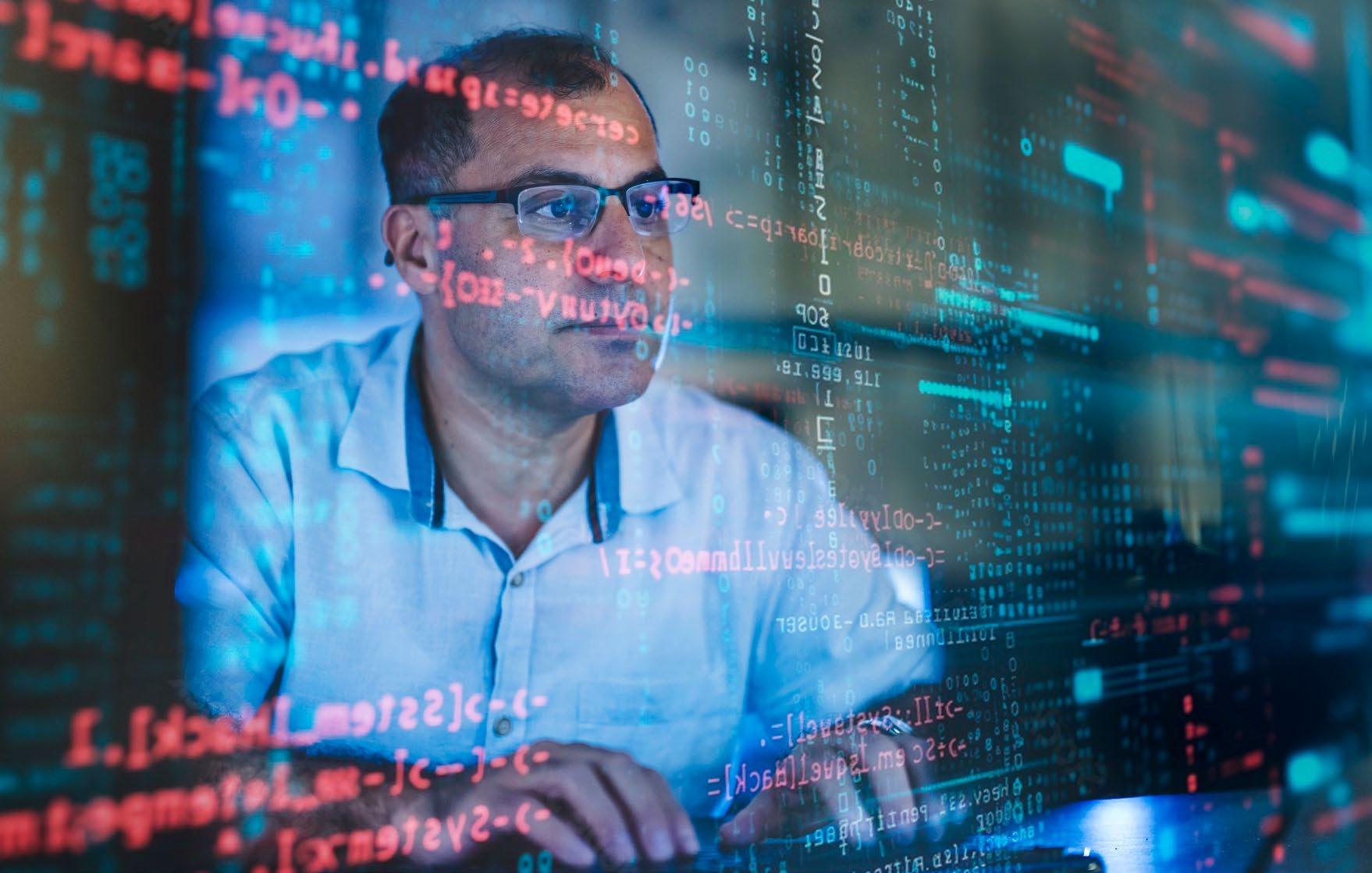
Where students learn to ‘think like a hacker’
IN THE 15 YEARS Selcuk Uluagac has been an active researcher in cybersecurity, he’s learned one thing: Bad guys will always find a way to get into your system. So the eminent scholar chaired professor in the Knight Foundation School of Computing and Information Sciences has the students in his Cyber-Physical Systems Security Lab work hands-on with every operating system and smart device imaginable to understand how different companies approach security. “If you learn to think like a hacker, you stay one step ahead,” he says. “When you understand how things fall apart and break, you become a better defender.”
Uluagac collaborates with Google, Microsoft and other industry leaders to advance research and prepare the next generation of cyberwarriors to take on the rising threat of increasingly sophisticated, profit-driven cybercriminals. He says ransomware is the “No. 1 arms race between hackers and cybersecurity experts today.” This type of malicious software holds sensitive personal data hostage in exchange for payment. Nearly every U.S. organization has been targeted: Fortune 500 companies, banks, governments, hospitals, insurance companies, schools. Says Uluagac, “It’s totally paralyzing. That’s why companies end up paying. In 2023, the payouts exceeded $1.1 billion.”
Today he’s using his expertise to help manage a diverse portfolio of projects and guide decisions on new directions for cybersecurity and privacy research projects as program director of the National Science Foundation’s Secure and Trustworthy Cyberspace (SaTC) program.

WHEN A POWER OUTAGE affects an entire city –everything from sewer systems to traffic lights and hospitals are impacted. For situations like these, secure and resilient electricity-generation and transmission infrastructure are needed. With funding from the U.S. Department of Homeland Security (DHS), a team from the Knight Foundation School of Computing and Information Sciences is using machine learning and AI to develop advanced solutions for critical infrastructure resilience, as well as bolster cybersecurity to combat hackers who can threaten critical infrastructure via cyberattacks. The grant makes possible the newly established Advanced Education and Research for Machine Learning-driven Critical Infrastructure Resilience (ADMIRE) Center, which equips students with the experience they need to excel in areas aligned with the DHS mission, including cybersecurity, machine learning and critical infrastructure resilience. “Our goal is to conduct cutting-edge research on AI for emerging resilience and cybersecurity challenges of critical infrastructures, enhance education, research and workforce development in STEM areas related to homeland security while building capacity for students and faculty to make connections with the agencies and private companies in this area,” says Hadi Amini, director of the ADMIRE Center.
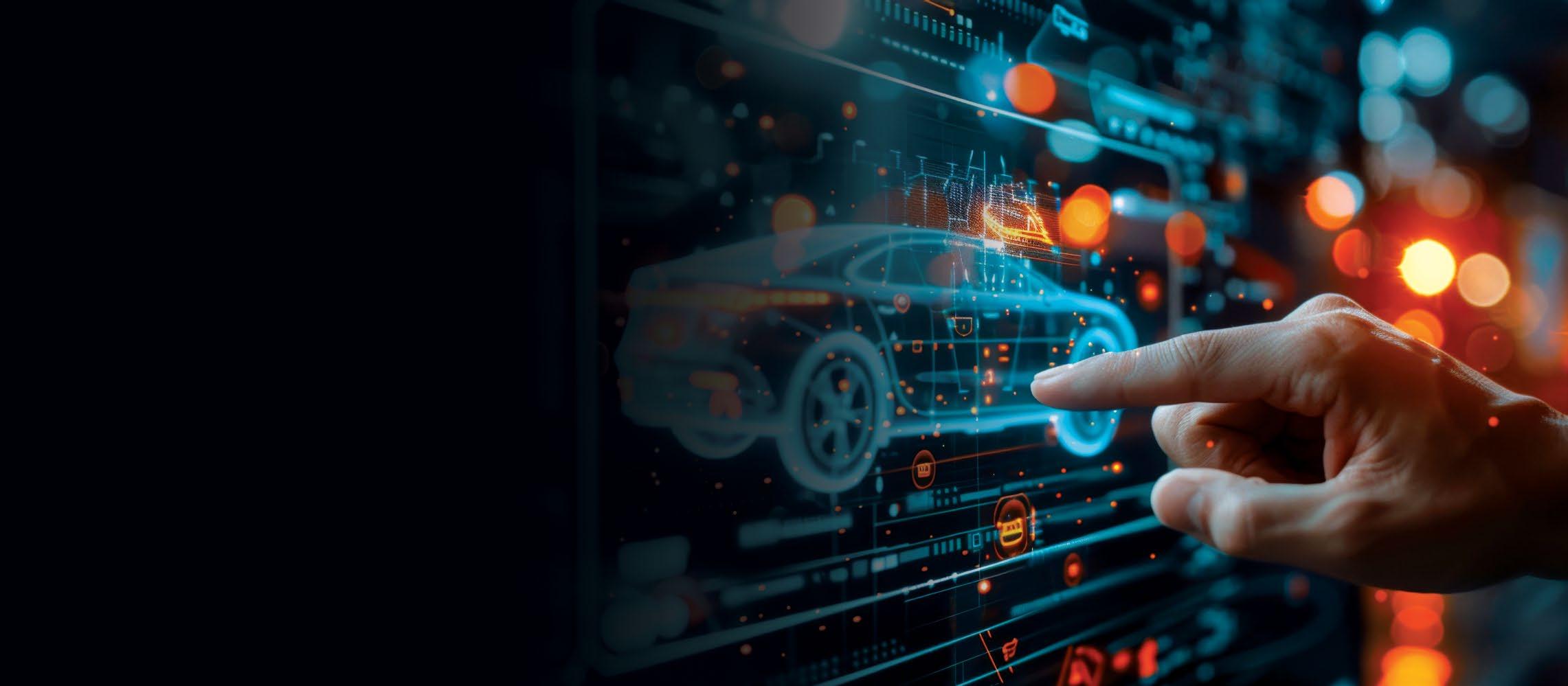
MODERN CARS present a potential privacy nightmare. Many are equipped with advanced sensors and cameras that track where you go and capture your face, voice and fingerprint. This personal information can then be stored on cloud servers to help AI algorithms “teach” cars how to keep drivers safe.
Hadi Amini, a cybersecurity researcher in the Knight Foundation School of Computing and Information Sciences, investigates new tools to protect drivers’ privacy. He’s searching for ways cars can analyze data but only send suggestions – not the actual data –to the server. Amini also leads investigations into AI as part of the U.S. Department of Transportation-funded National Center for Transportation Cybersecurity and Resiliency that aims to safeguard transportation systems from cyberattacks.
BY ANGELA NICOLETTI
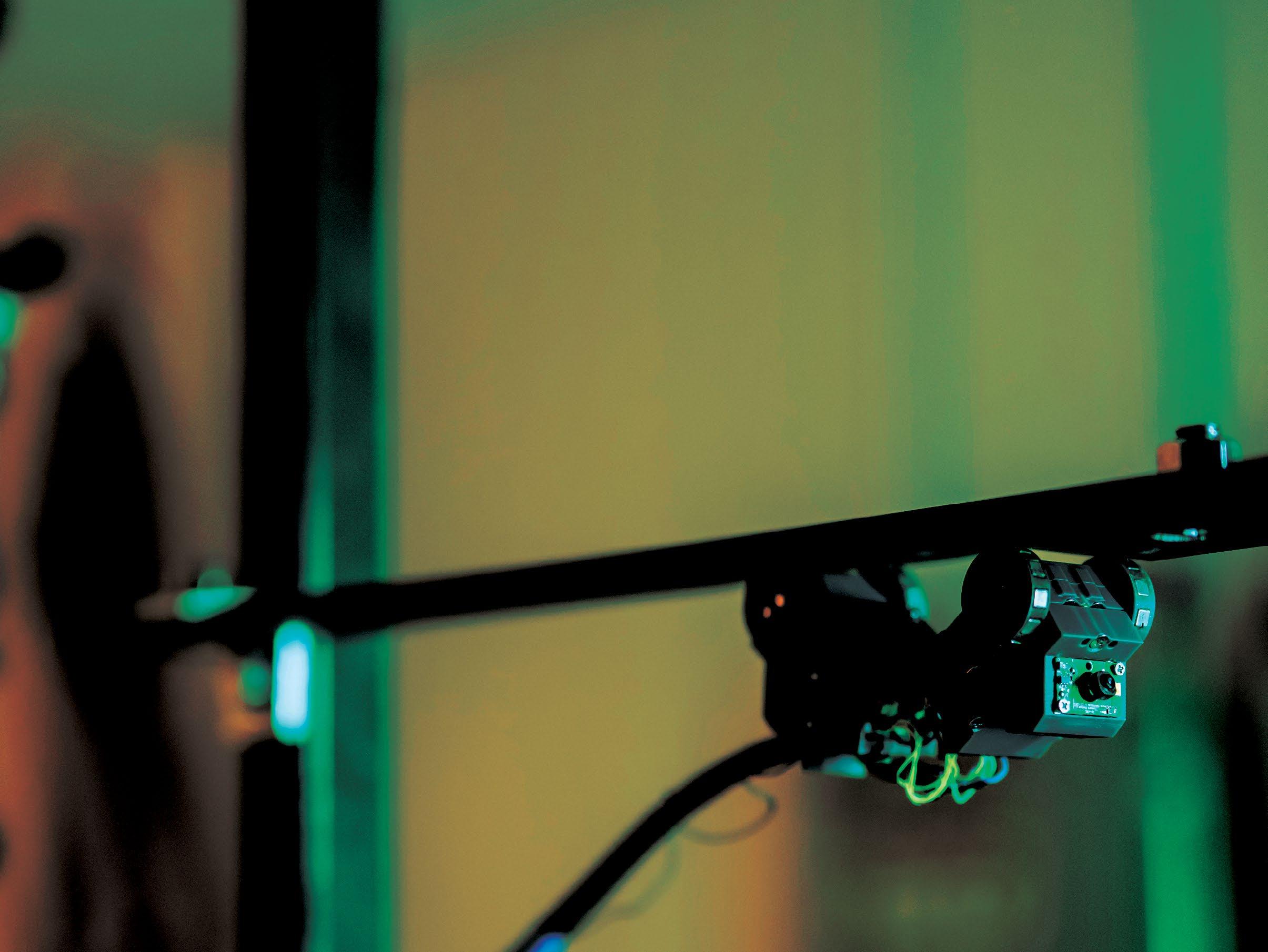


FIVE DECADES of nuclear energy research and weapons development left behind a toxic environmental legacy. Clean up became its own priority mission. The U.S. Department of Energy’s Office of Environmental Management has deactivated, decommissioned, decontaminated and deconstructed over 90 sites. Today, only 15 remain.
FIU Applied Research Center scientists are sending in their robotic systems to help DOE with this massive undertaking. Each one of their systems is designed and meticulously programmed to meet DOE needs. Many robots are built from the ground up. Like one with heavy-duty wheels meant to cart around tools, including drills and cutters, to collect samples and make repairs. Or the “wall crawler” that, as its name suggests, climbs vertically to apply spray coatings to radiologically contaminated surfaces. Other crawlers squeeze into the tightest of spaces and have already gone underground to check for leaks at the Hanford site where buried tanks contain 56 million gallons of radioactive waste.
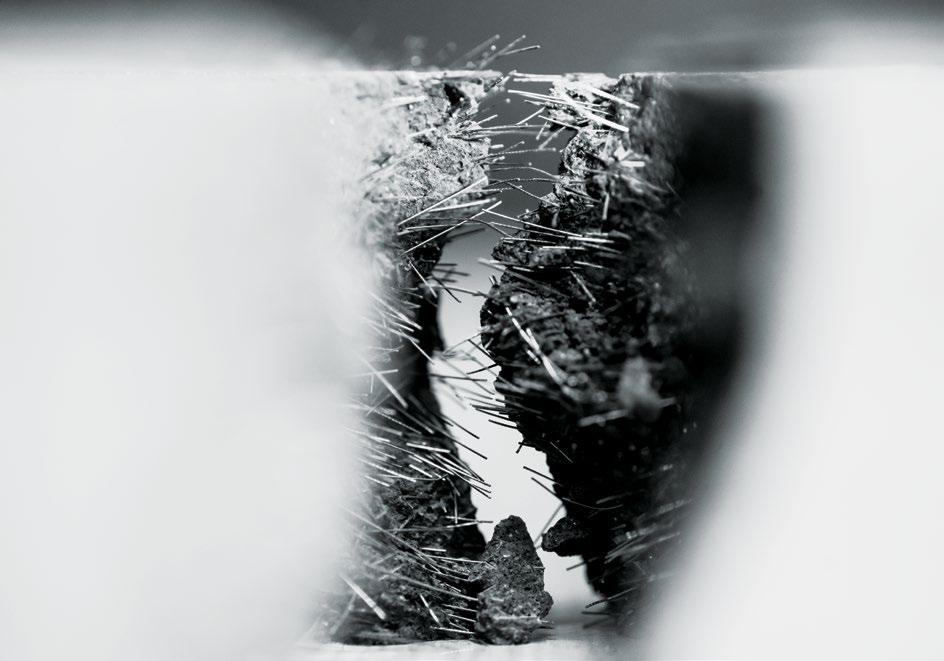

Azizinamini developed an open source, cost-effective sprayable UHPC with funding from the U.S. Army Corps. In collaboration with the Northern Virginia District of the Virginia Department of Transportation, FIU’s UHPC was recently used for the first time to repair a bridge in the U.S.
ULTRA-HIGH PERFORMANCE CONCRETE – or UHPC – is five times stronger than conventional concrete. “Just applying a shell of UHPC around a structure, like a bridge column, adds to its total strength and makes it almost maintenance free for life,” explains Atorod Azizinamini, director of infrastructure, research and innovation at FIU and a leading bridge engineering expert who holds a patent for this UHPC shell framework concept.
Made with a mix of durable materials like steel fibers and very fine sand (rather than standard aggregate like rocks or gravel), UHPC has become an ideal candidate for the 40,000+ U.S. bridges and other aging infrastructure in need of repair or maintenance. Another benefit: It is saltwater resistant, making it perfectly suited for coastal structures prone to damaging corrosion.
Azizinamini is currently exploring new ways to maximize the advantages of UHPC through additive construction – along with the team he leads at the USDOT-funded Innovative Bridge Technologies/Accelerated Bridge Construction University Transportation Center (IBT/ABC-UTC). One technique involves robotic equipment to create site-specific, 3D-printed structural pieces for retrofitting or reinforcement. Another is the use of UHPC in conjunction with pneumatic or “shotcrete” spraying.
WHEN A FISH KILL HAPPENED in Miami’s Biscayne Bay in 2020, Todd Crowl – director of the FIU Institute of Environment –quickly assembled a team that deployed buoys and autonomous vessels equipped with special sensors that measure temperature, salinity, dissolved oxygen, chlorophyll and more. The data soon painted the full picture of what was happening: Too-hot water temperatures coupled with significant nutrient pollution had caused oxygen levels to plummet.
Fast-forward five years. The bay’s health remains in flux. And FIU’s robotics continue to patrol the waters. The autonomous vessels start as prototypes that get tested at a Department of Defense-funded tank facility, located at FIU’s Biscayne Bay Campus, before being deployed in the bay.
Data scientists like Gregory Murad Reis give them directions to their destinations. Reis and his computer science students create software technology and visualization tools, like dashboards and color-coded maps, to make this important water quality data accessible and understandable for policymakers and the public.
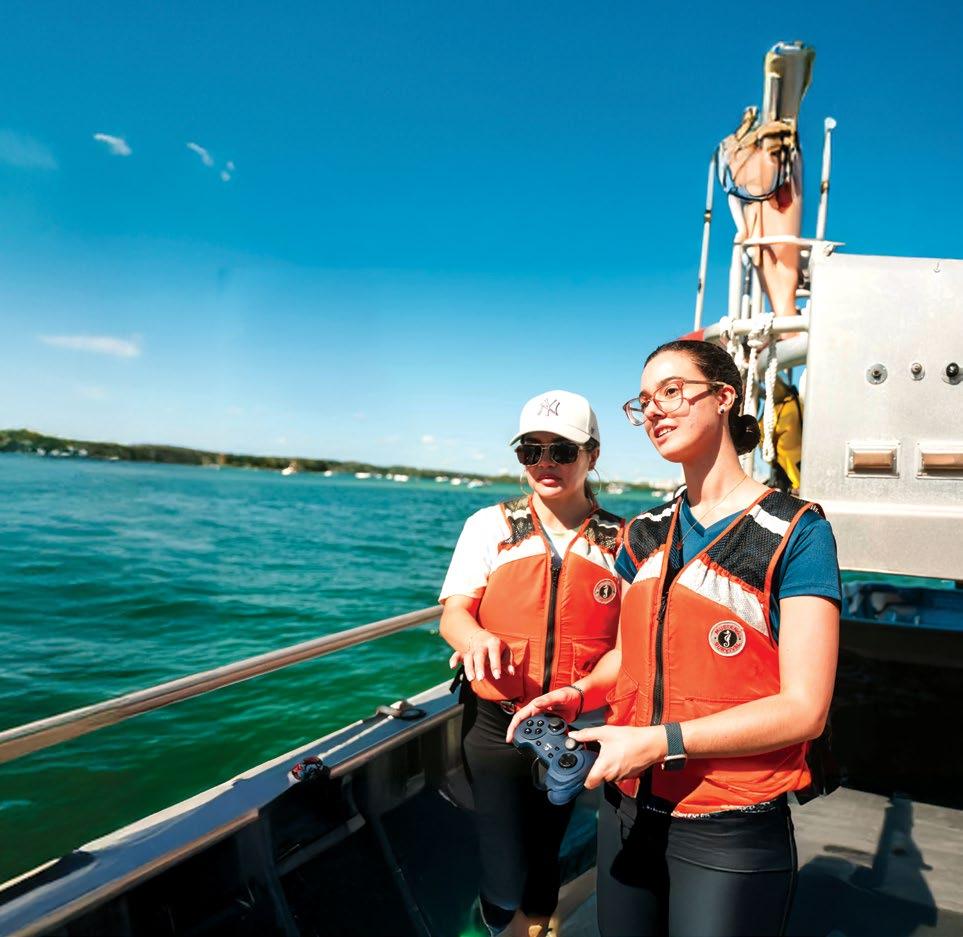
Computer science students Monica Burbano and Valerie Benedit operate an autonomous surface robot in Biscayne Bay.
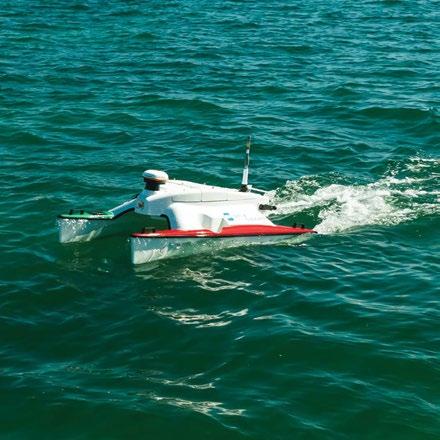
Coming soon: The Robotics and Autonomous Systems Laboratory for Coastal Conservation and Restoration. This hub for marine robotics research will be the only facility of its kind at a university. It was made possible through a $9 million congressional appropriation from the National Institute of Standards and Technologies.
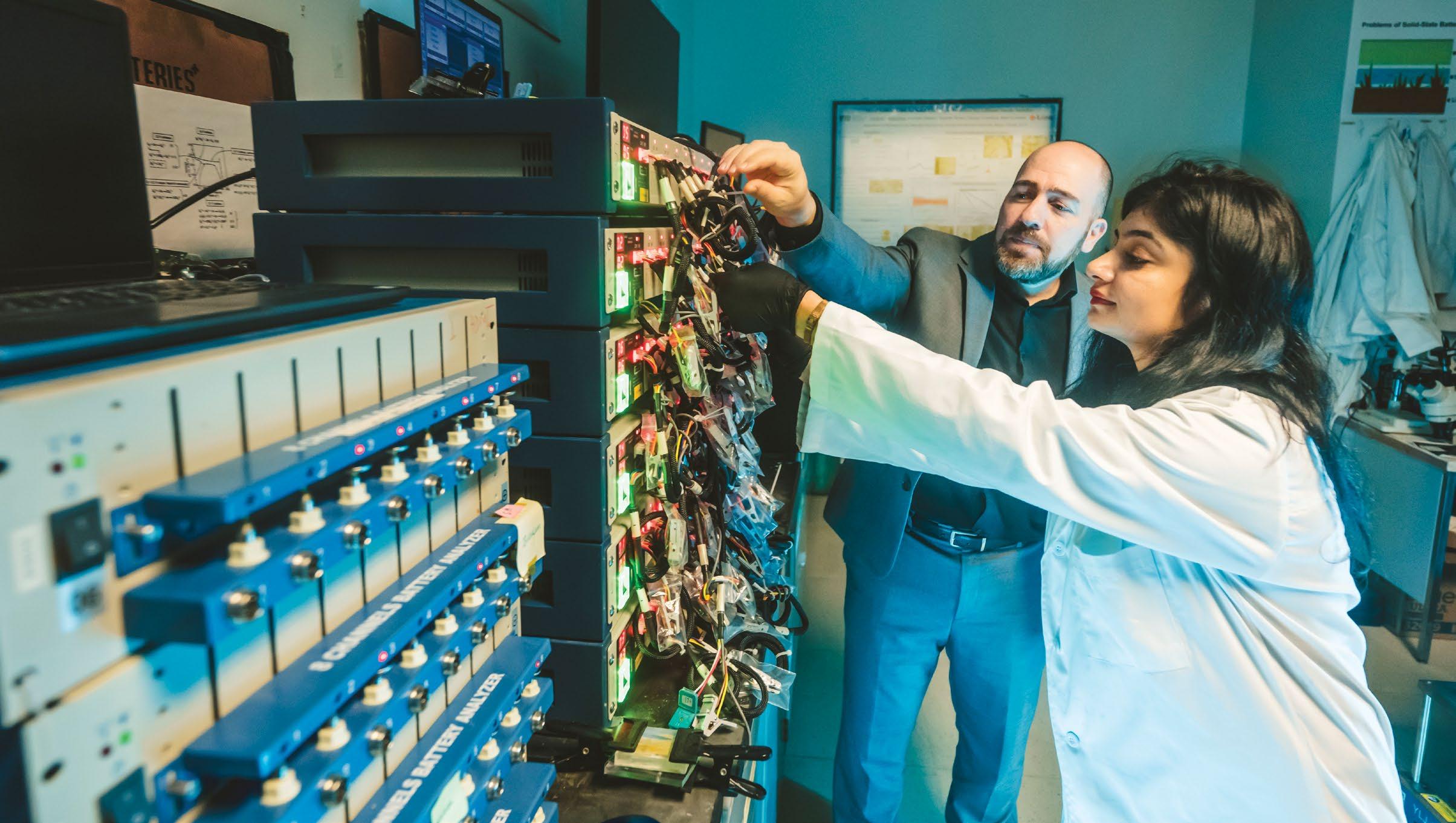
LAPTOPS, SMART PHONES and electric vehicles have all evolved dramatically in the last few decades. The batteries that power them? Not so much. At this point, lithium-ion is decades old technology. Batteries have essentially become “the bottleneck in technology,” explains Bilal El-Zahab, who leads FIU’s Battery Research Laboratory.
El-Zahab has spent over a decade working on beyond lithium-ion battery technologies such as solid-state, lithium-sulfur and lithium-air batteries. Part of this research involves how metals like palladium and platinum can be used to improve cycling charge capacity – giving batteries a boost in performance and a longer lifespan.
One resulting innovation is a patented lithium-sulfur battery that is both lightweight and incredibly energy dense, meaning more charge can be carried. “Instead of using a 1,000-pound EV battery, you could have one that’s 500 pounds and get the same driving range,” El-Zahab said. “Or you could keep the battery the same size, replace it with our cells and get double the range.” Currently, it’s being pushed to its limits in a third-party lab – an important step before commercialization.
Lion Battery Technologies has provided $4M in research and development support for El-Zahab’s battery research.

BATTERY ENERGY storage systems and renewable energy must “work together hand in hand,” says Daniela Radu, who researches nanomaterials for the next generation of solar cells at FIU. “That’s how you get to energy zero.”
This seamless integration is the goal of the Center of Excellence for Integrated Renewable Energy and Energy Storage. Established with a $10 million investment from the Department of Defense (DoD), FIU leads this multi-year project – that includes collaborators from Pennsylvania State University – to find new energy solutions that support DoD’s strategic commitment to making climate resilience a national security priority.
“If you look at traditional solar panels, the first thing that comes to mind is they’re very heavy,” says Radu, the project’s principal investigator. “Soldiers carry a lot in the field, so imagine having to carry heavy solar panels and batteries on top of it. We’re aiming to create lightweight, foldable, portable alternatives.”
Additionally, the researchers want to incorporate Earth crust elements that are more readily available in the U.S. like copper, while maximizing power conversion efficiency by capitalizing not just on photons in sunlight but any light source, including indoor light bulbs.
All of this will connect to a microgrid. Unlike the traditional power grid that’s interconnected and delivers electricity to many homes or businesses, a microgrid acts independently or in “island” mode – especially important for soldiers stationed in remote areas.

MICROGRID TECHNOLOGY is uniquely capable of protecting the reliability of our energy supply in the wake of extreme weather events such as wildfires and hurricanes. As part of a decades-long effort to advance renewable energy technologies, FIU – in partnership with Florida Power & Light Company – conducts groundbreaking research on the AI-based renewable microgrid installed at the university’s engineering center. This research can help pave the road for providing local and global communities with increased resiliency for riding through extreme weather and power grid events, according to Arif Sarwat, principal investigator of the FIU-FPL microgrid and director of FIU’s Energy, Power and Sustainability-Intelligence research group.
In addition to the solar and battery storage-based microgrid, researchers at FIU leverage the Proactive Analytics and Data Oriented Research on Availability and Security (PANDORAS) Lab, which serves as a virtual distribution system control room and is interconnected to a real-time simulation lab. There, Sarwat’s research group uses high-end computer systems to conduct research and simulations using smart grid, weather and telecommunications data.
ECONOMIC IMPACT Florida #4
Total Department of Defense Spending (2023 Defense Spending by State report)

AU.S. SOUTHERN C OMMAND (SOUTHCOM) official located illegal fishing vessels in Latin America through FIU’s Illegal, Unregulated and Unreported Fishing (IUUF) dashboard, honing in on specific vessels that “went dark” or turned off systems that transmit a ship’s position – an indicator of illegal activity. This is an example of the impact resulting from a series of Department of Defense-funded dashboards created by the Security Research Hub – part of the Jack D. Gordon Institute for Public Policy. Drawing from over 400 data sets, each dashboard highlights different Latin American and Caribbean security issues. Current dashboards track China’s activities in Latin America and the Caribbean; arms seizures and thefts across Latin America; kidnappings in Haiti and more. The dashboards are a valuable resource for students, researchers, policymakers, journalists and more.

SEMICONDUCTORS are the foundation of most modern technology – from smart phones and other electronics to satellites. With National Institute of Standards and Technology funding, the Advanced Materials Engineering Research Institute (AMERI) will receive state-of-the art instrumentation to enhance semiconductor materials and devices fabrication. AMERI will also enable programs to provide entrepreneurial training to students to support their workforce readiness. This aligns with the goals of the CHIPS and Science Act, which aim to revitalize the U.S semiconductor industry, drive innovation and foster the creation of high-paying jobs.

FIU’S COLD SPRAY AND RAPID DEPOSITION LABORATORY gives researchers a place to push the boundaries of cold spray technology.
To date, they’ve developed and patented dozens of new advanced materials, such as high-strength aluminum composites, that can be fabricated using this technology for applications in the aerospace, automotive and defense industries. The lab is supported by $22.9 million from the U.S. Army Research Laboratory.
RESEARCHERS at the Applied Research Center (ARC) are collaborating with Alakai Defense Systems to attach special sensors – capable of detecting and identifying explosives, homemade explosives and toxic industrial chemicals from a distance – to ARC robotics. The detector can be used for defense, security, bomb squad and other law enforcement applications. The system can also be operated remotely, protecting people from the threat chemicals.
The Global Forensic and Justice Center (GFJC), a DoD contractor since 2008, has Alakai as a tenant and helped Alakai with this sensor’s library build. Learn more about FIU’s robotics research on pg. 6
RTIFICIAL INTELLIGENCE expert
Mark Finlayson studies how to train AI to detect when people use stories, especially those that spread on social media, for malicious purposes to spread disinformation.
An eminent scholar chaired associate professor of computer science in the Knight Foundation School of Computing and Information Sciences, Finlayson specializes in an area of AI called natural language processing. He’s creating algorithms capable of sifting through lengthy text to collect building blocks that make up the structure of a story to find reoccurring or related themes appearing in different online stories to better identify those being used to spread misinformation and disinformation. The Department of Defense and Department of Homeland Security have funded Finlayson’s research.

READY TO COLLABORATE? FIU has been awarded contracts by the Department of Defense that allow for collaboration worth up to $360M in the areas of analytic support, Open Source Intelligence, climate and environmental resilience, training and education, modeling and simulation, engineering support and more. To learn more, please visit go.fiu.edu/ResearchCollaboration
Stacked against other societal problems, a slow wireless connection may seem insignificant. Except it’s a little more complicated. Without a way to move data at lightning-fast speeds, society risks a period of stasis. Progress could stall across critically important areas – education, business, healthcare and medicine, remote sensing of the environment, space exploration, national security.
Stavros Georgakopoulos, an electrical engineer at FIU, has spent 30 years developing new telecommunications technologies to keep our world moving forward. What concerns him most is our wireless communication systems. They are fast. Just not fast enough.
“Big data has become a buzz word, but we’re at a point where there’s so much data to be transmitted and processed very quickly. How will we do it? We need more powerful wireless links to keep up,” said Georgakopoulos.
A faster future relies on what Georgakopoulos calls the “eyes and ears of the entire system” – antennas. Without this critical component, there’d be no Wi-Fi, cellphone reception, Bluetooth, GPS, as well as television or radio. Data would remain trapped in
the hardware of our devices, like digital messages in a bottle.
At FIU’s Transforming Antennas Center (TAC), Georgakopoulos leads the research and development into the next generation of foldable, deployable, reconfigurable systems that operate at higher frequencies. Higher frequency equals faster data speeds and larger bandwidth. For comparison, most smartphones operate at one to six gigahertz (GHz), while only the latest models can cover up to 39 GHz. Georgakopoulos and the TAC team are creating antennas that cover frequencies from 30 to 100 GHz – unprecedented, considering there’s nothing quite like it in existence.
Equal parts elegant and powerful, Georgakopoulos’s patented designs are about the farthest thing from rabbit ears on a television set or rooftop satellite dishes. Instead, they take inspiration from origami, Japan’s centuries-old artform where behind every bend or crease, complex mathematics and geometry turn a sheet of paper into a three-dimensional shape.
Origami is all about transformation. And antennas require transformation to change their function. Controlling the shape controls performance. That’s why
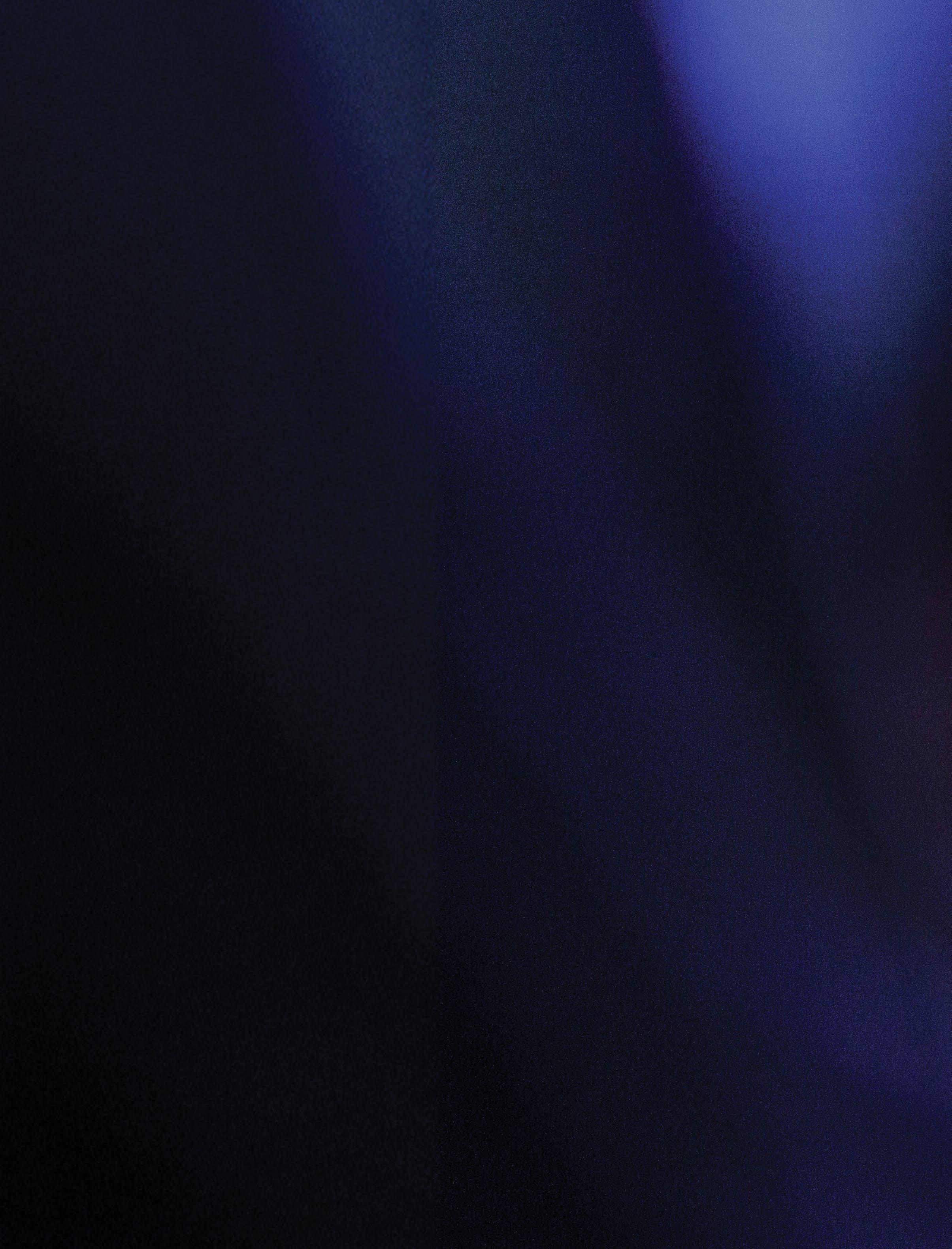
back in the day, adjusting an antenna up and down helped pick up a radio or TV station. Origami allows for the same thing, in a different way.
Made of various materials – including plastic films, textiles and flexible conductors – Georgakopoulos’s antennas are lightweight, surprisingly durable shapeshifters capable of doing the job of multiple antennas. Instead of lugging around several bulky antennas to transmit and receive messages, soldiers in the field or scientists on expeditions could carry just one.
Packability is also especially important for space communications.
Georgakopoulos first started delving deeper into origami techniques with a National Science Foundation (NSF) Emerging Frontier in Research and Innovation grant, co-funded by the Department of Defense’s Air Force Office of Scientific Research (AFOSR).
Then with two additional AFOSR grants, totaling close to $10 million, Georgakopoulos launched TAC. Today, 60 researchers work out of TAC –including FIU undergraduate, graduate, postdoctoral students, along with collaborators from Georgia Institute of Technology, Cornell and Brigham Young University.
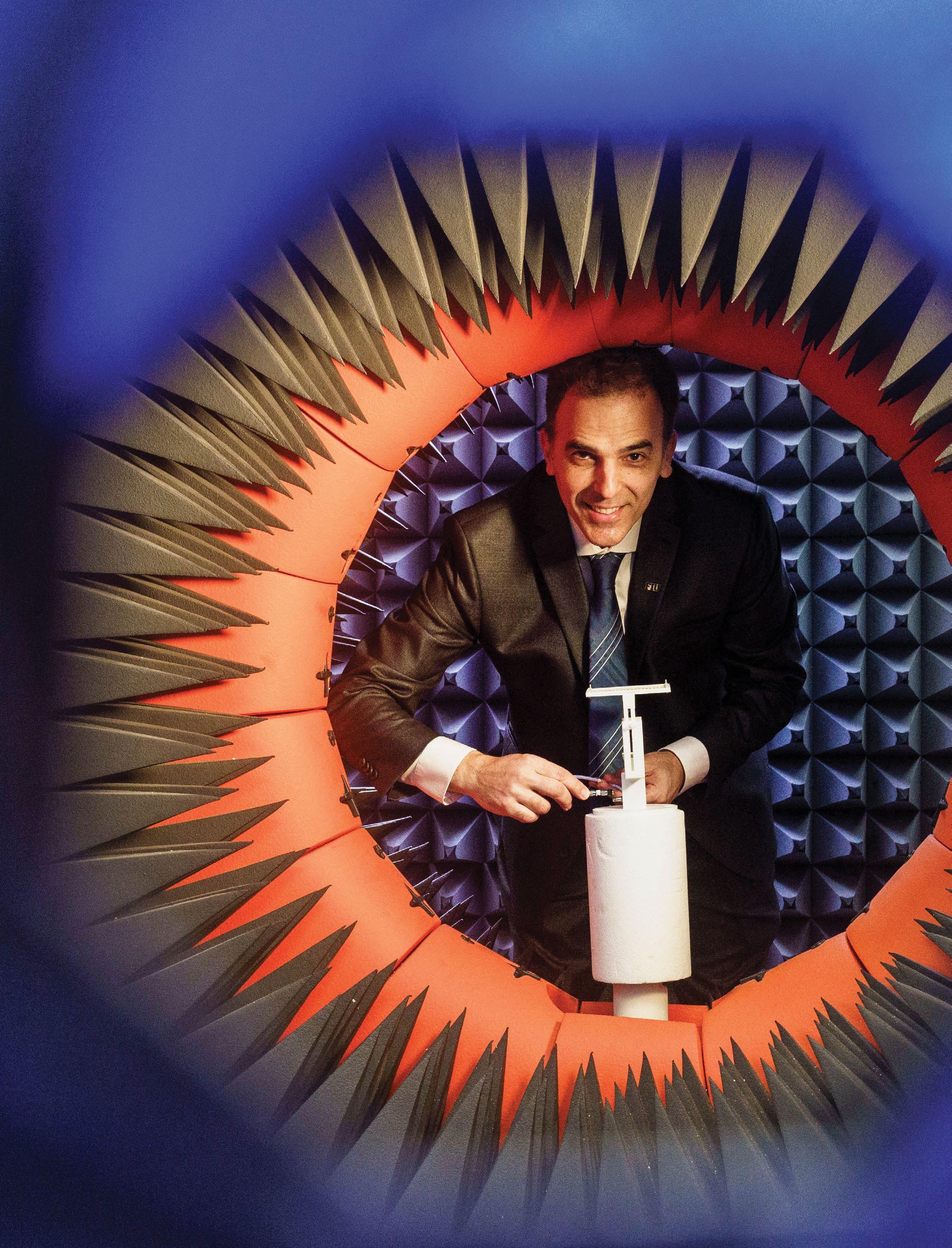
Georgakopoulos’s antenna research has been awarded +$15 million in federal funding from the NSF and the Department of Defense’s Air Force Office of Scientific Research.

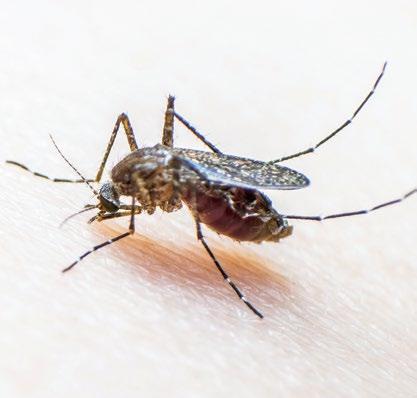
Understanding how mosquitoes detect humans is key to building a next-generation mosquito repellant.
MOSQUITOES are the deadliest animals on the planet, killing hundreds of thousands of people annually through the spread of disease. Neurogeneticist Matthew DeGennaro is on the hunt for a lifesaving perfume.
DeGennaro is the first scientist to make a mutant mosquito – a game-changing tool in researching mosquito behavior. Secured in his Tropical Genetics Lab, DeGennaro relies on his mutants to help answer globally critical questions such as how mosquitoes find people. In 2019, he, with the help of his students, identified the olfactory receptor mosquitoes rely on to detect people. His focus has now shifted to finding a scent to disrupt that receptor. His research has been supported by the Centers for Disease Control and Prevention, National Institutes of Health, and U.S. Department of Defense.
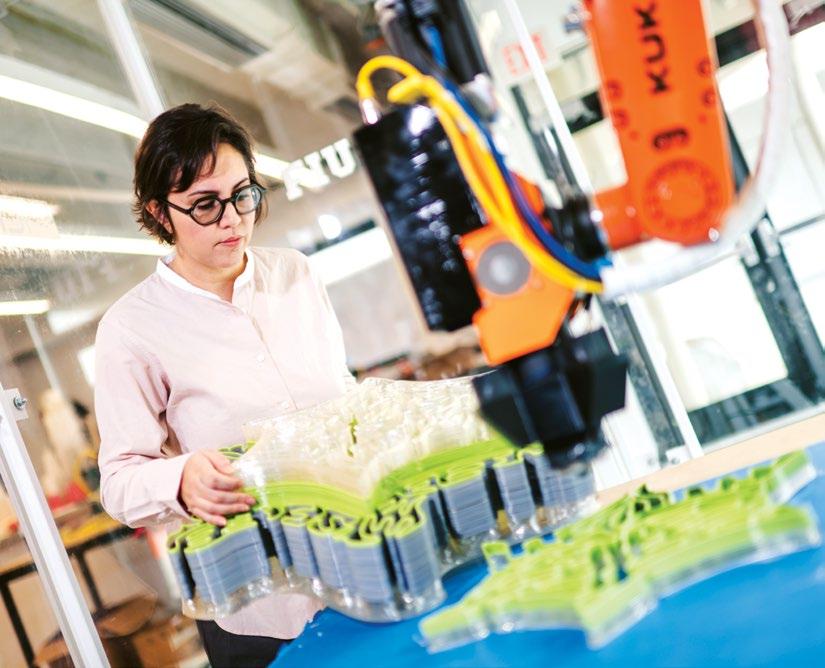
INSPIRED by the pattern and texture of coral, Ecoblox are transforming seawalls into something beautiful and beneficial to the environment. Architect Sara Pezeshk’s artful modular system is designed to nurture biodiversity and enhance marine ecosystems. Each fold and crevice is algorithmically shaped using computational codes, integrated with data from scientific journals – for example, the exact crevice sizes oysters prefer for
habitat – to generate the ideal homes for these essential filter-feeder species. Designs are fabricated using 3D printing to be attached to existing seawalls. Pezeshk is principal investigator of the NSF-funded project. She and Shahin Vassigh, director of FIU’s Robotics and Digital Fabrication Lab, recently received new support from the EPA to further this work, and soon Ecoblox will be installed at sites in Miami’s Biscayne Bay for field testing.
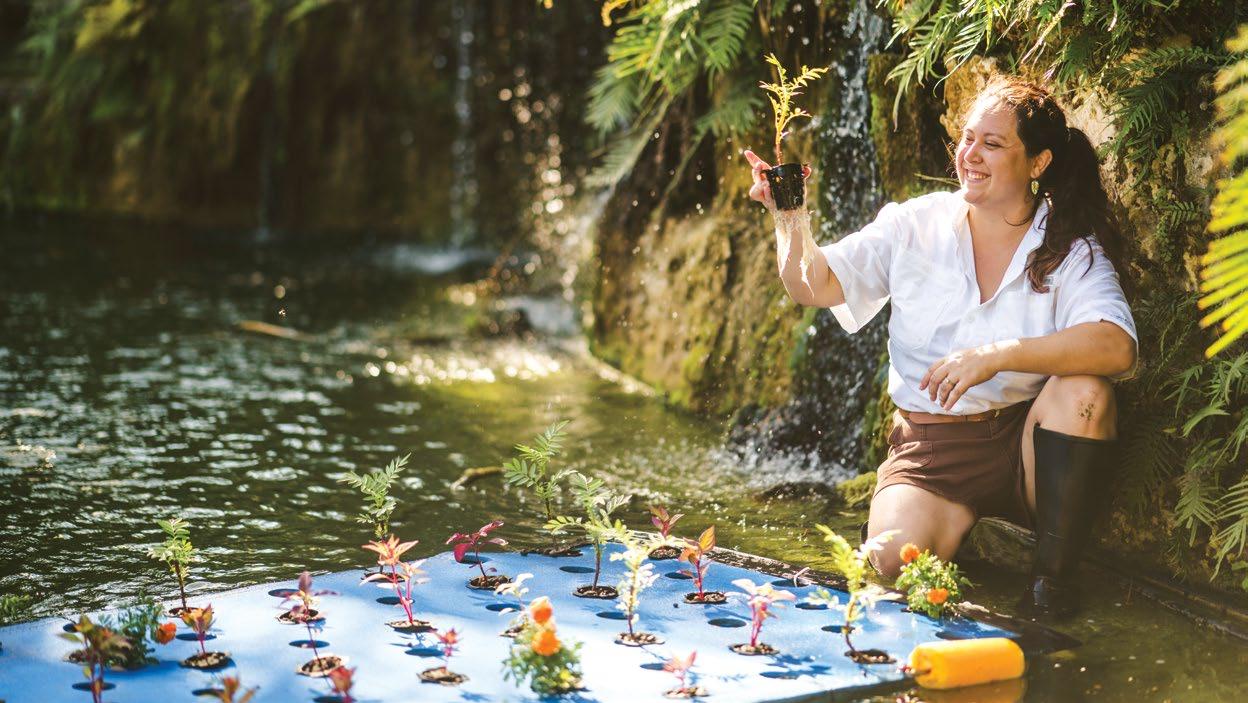
RAIN WASHES phosphorus, nitrogen and other chemicals from farms, lawns and even septic tanks into lakes, rivers, bays and other marine ecosystems. Flowers may help remove some of these harmful pollutants from the water. Inspired by traditional floating farm practices such as the Miccosukee Tribe of Indians of Florida’s tree island settlements, Institute of Environment researchers Jazmin Locke-Rodriguez and Krishnaswamy Jayachandran grew flowers on inexpensive mats designed to float on the water’s surface. Large marigolds were most successful at filtering pollutants, removing 52% more phosphorus and 33% more nitrogen than would naturally be removed from the water. Locke-Rodriguez is exploring ways to bring this research to market and scale up floating farms in South Florida. The U.S. Department of Agriculture and National Science Foundation funded this research.

PFAS ARE IN MIAMI’S RAINWATER. It’s the latest evidence the synthetic “forever chemicals” that have raised health concerns for people and wildlife hitch a ride on the water cycle, using the complex system to circulate over greater distances.
Chemist Natalia Soares Quinete and members of her research group spent a year analyzing water samples from sites around Miami-Dade County. They detected PFAS in drinking water and surface water –including Biscayne Bay – and also found PFAS in animals that live in those areas.
While profiles of several PFAS matched back to local sources, others did not. According to the group’s published study, this suggests Earth’s atmosphere acts as a pathway to transport these chemicals far and wide, contributing to the worldwide pollution problem.
The team hopes the data can help guide future solutions and regulations for controlling and reducing PFAS.
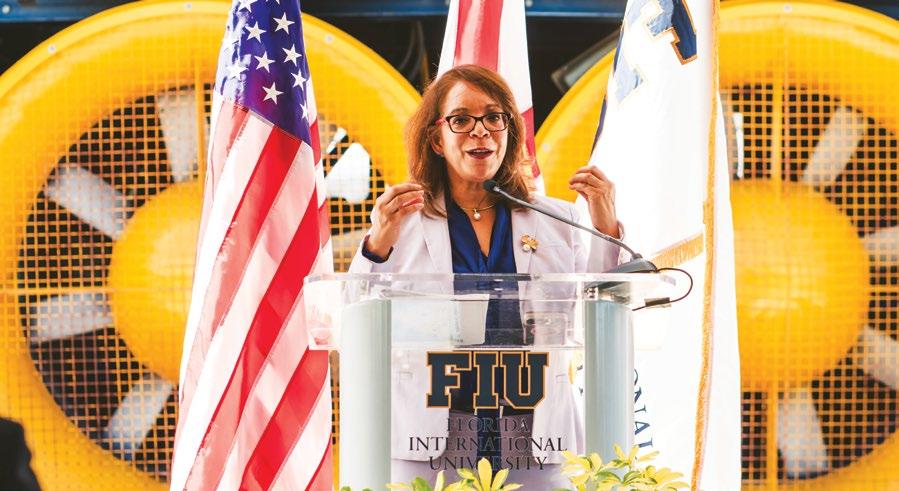
Then-U.S. Assistant Secretary of Commerce for Economic Development Alejandra Y. Castillo visited FIU to make the nationwide announcement about funding for the South Florida ClimateReady Tech Hub.
SOUTH FLORIDA was selected to be the home of the nation’s climate-ready tech hub. It aims to advance sustainable and resilient infrastructure while scaling up the production and delivery of critical technologies that will strengthen America’s clean energy transition and national security. Of the $19 million in federal funding from the Department of Commerce’s Economic Development Administration, $10 million will go to FIU to support:
• TECHNOLOGY DEVELOPMENT AND MATURATION: Accelerate the readiness and expand deployment of cement technologies like FIU’s Ultra High Performance Concrete.
• CLIMATE READY INFRASTRUCTURE INNOVATION CENTER: Over the next five years, services and mentorship will be provided to at least 60 infrastructure innovation startups and small businesses.
• INDUSTRY CODES AND STANDARDS: FIU’s Wall of Wind will help researchers continue to provide expertise and input for the improvement of building codes and standards, work on policies that incorporate new materials and technologies, and give regulators guidance on which standards to enforce and recommendations to streamline the approval process.
Take a closer look at how FIU is leading this effort in the infographic on the next page.
THE SOUTH FLORIDA CLIMATEREADY TECH HUB is led by Miami-Dade County and includes Broward, Monroe and Palm Beach counties and over 40 research and small business partners throughout the region. Funded by the U.S. Department of Commerce’s Economic Development Administration, this program will develop, commercialize and scale tech focused on sustainable and climate resilient infrastructure. FIU is leveraging its deep expertise and world-class research facilities to lead the infrastructure component of this effort in safeguarding our coastal cities and beyond.
The Climate Ready Infrastructure Innovation Center will provide services and mentorship to startups and small businesses focused on climate-ready infrastructure.
With Titan America and Carbon Limit, FIU is advancing lowcarbon cement technologies, like ultra-high performance concrete, to enhance durability, reduce concrete emissions and in some cases, turn concrete into a carbon-absorbing sponge.

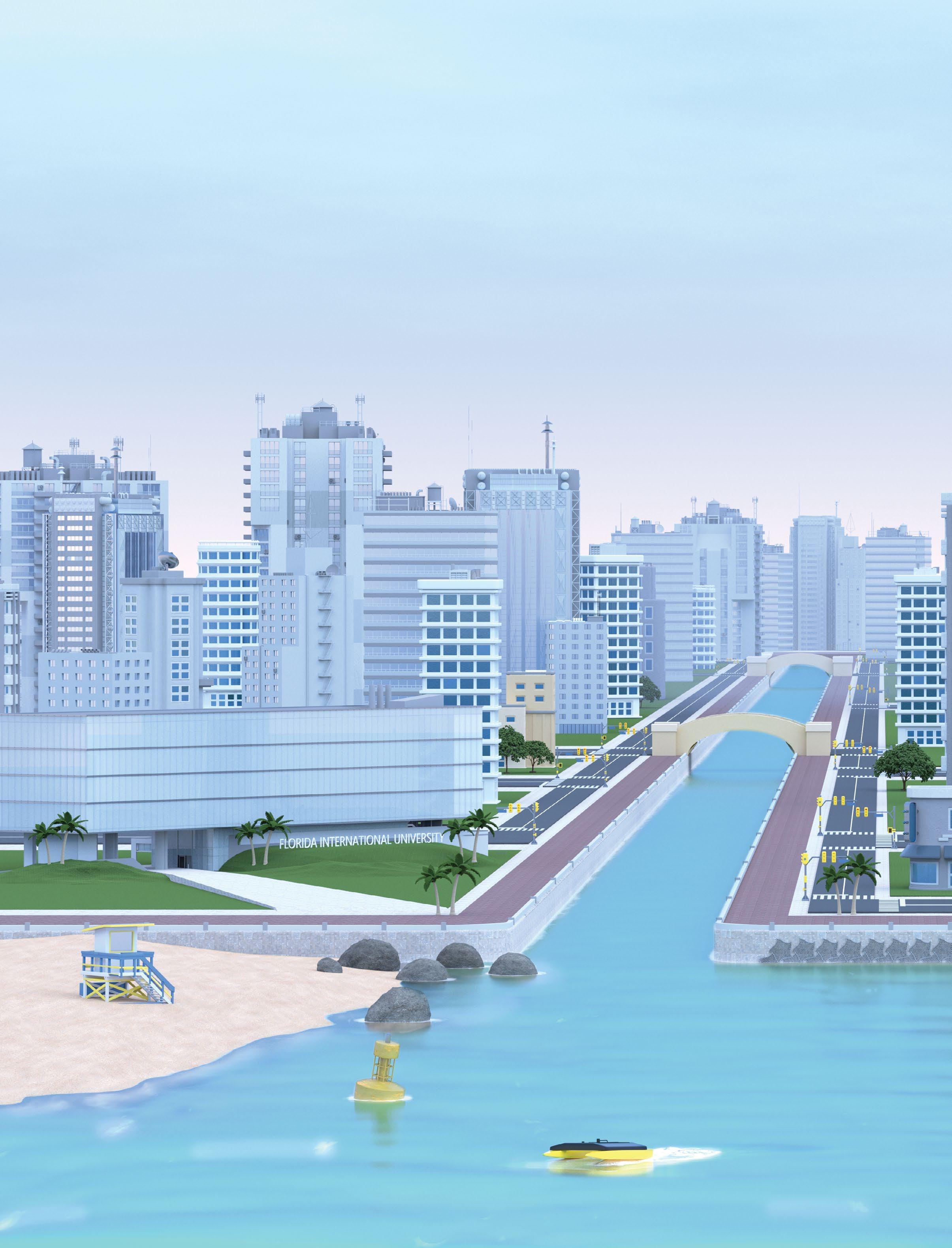
Designed to attach to existing seawalls, Ecoblox was invented to enhance marine biodiversity and mitigate water pollution in coastal areas.
Capable of generating Category 5 winds, this facility has contributed to Florida’s leading position in building codes for hurricanes. It will be used by Tech Hub partners to test new materials and innovative products in development.
With over $25 million in funding from the U.S. Army Research Laboratory, FIU’s Cold Spray and Rapid Deposition Lab advances techniques in the repair, design and durability of high-performance materials with applications for commercial aviation, automobiles and more.
Supported by FPL/NextEra, the AI-based microgrid advances research into a resilient energy future in the face of natural disasters.
Federal support from Congress and NOAA is launching a network of monitoring wells to study the impact of saltwater intrusion on the foundations of coastal buildings.
Researchers design and deploy buoys and autonomous vessels to identify and trace emerging contaminants in coastal environments.


*For representational purposes only. Rendering not to scale.
BY JOANN ADKINS
Mike Heithaus has spent more than 20 years studying the ecological role of sharks, amassing a portfolio of work that has changed the world’s understanding of sharks and their roles in keeping oceans healthy. This includes 20+ years working in Shark Bay, Australia – producing the most detailed study on the ecological role of sharks in the world, which has been used as the underpinning for affecting positive policy changes –and Global FinPrint, an ambitious worldwide effort to survey the world’s reef shark and ray populations
Now, Heithaus and 29 other scientists from around the world have published an extensive review examining the ecological importance of sharks. Their comprehensive assessment, published in the academic journal Science, looked at more than 100 studies and reveals shark conservation must go beyond simply protecting shark populations. It must prioritize protecting the ecological roles of sharks. According to Heithaus, executive dean of FIU’s College of Arts, Sciences & Education and vice provost of environmental resilience, the main takeaway is pretty simple: “If people want healthy oceans, we need healthy shark populations.”
The largest sharks of many of the biggest species, such as tiger sharks and great whites, play an oversized role in healthy oceans, but they are often the most affected by fishing. These big sharks help maintain balance through their eating habits. Sometimes their sheer size is enough to scare away prey that could over-consume seagrass and other plant life needed for healthy oceans.
Besides helping to maintain balance in food webs, sharks feed in offshore waters and bring nutrients back to the reef. Others move nutrients around that are used at the base of the food chain. Sharks can also serve as food for other species and even as scratching posts for fish to remove parasites.
Altogether this means a variety of sharks are needed in ecosystems, yet their many and diverse contributions to ocean health are under threat from overfishing, climate change, habitat loss, energy mining, shipping activities and more.
The issue of shark conservation becomes all the more critical as global temperatures increase, leading some sharks to head into new areas where they can find the temperatures they thrive in. In addition, with the expansion of blue economy industries like aquaculture and tourism, people’s encounters with sharks will likely increase. Finding a balance that protects the sharks most needed for healthy oceans is hitting a critical point.
“When we look around the world, we see that sharks can play lots of different roles in ecosystems – and some of them are really important,” Heithaus said. “That means we need to maintain a diversity of sharks in our oceans, as well as a wide range of sizes of sharks. It also means we need to be rebuilding heavily depleted populations and managing for how sharks will function in oceans that are changing due to human uses and climate change.”
Today, Heithaus continues to expand his shark research, including collaborative efforts to fill data gaps. When he joined FIU as a faculty member in 2003, he was the lone shark researcher. Now, FIU has assembled one of the largest university shark teams in the country. With support from the National Science Foundation, Paul G. Allen Family Foundation, Pew Charitable Trust, Batchelor Foundation, National Geographic and others, their research has greatly expanded scientific knowledge of shark roles, behavior and conservation strategies and has been used to support successful bids to expand shark protections through the Convention on International Trade in Endangered Species of Wild Fauna and Flora.
As global temperatures increase, some sharks are heading into new areas where they can find the temperatures they thrive in. In addition, with the expansion of blue economy industries like aquaculture and tourism, people’s encounters with sharks will likely increase. Finding a balance that protects the sharks most needed for healthy oceans is hitting a critical point.
71%
of shark abundance has plummeted for oceanic species in the past 50 years.
63%
of the five most common reef shark species have been depleted and sharks are no longer performing viable ecological roles on at least 20% of reefs worldwide.
<2% of protected areas adequately protect shark species.
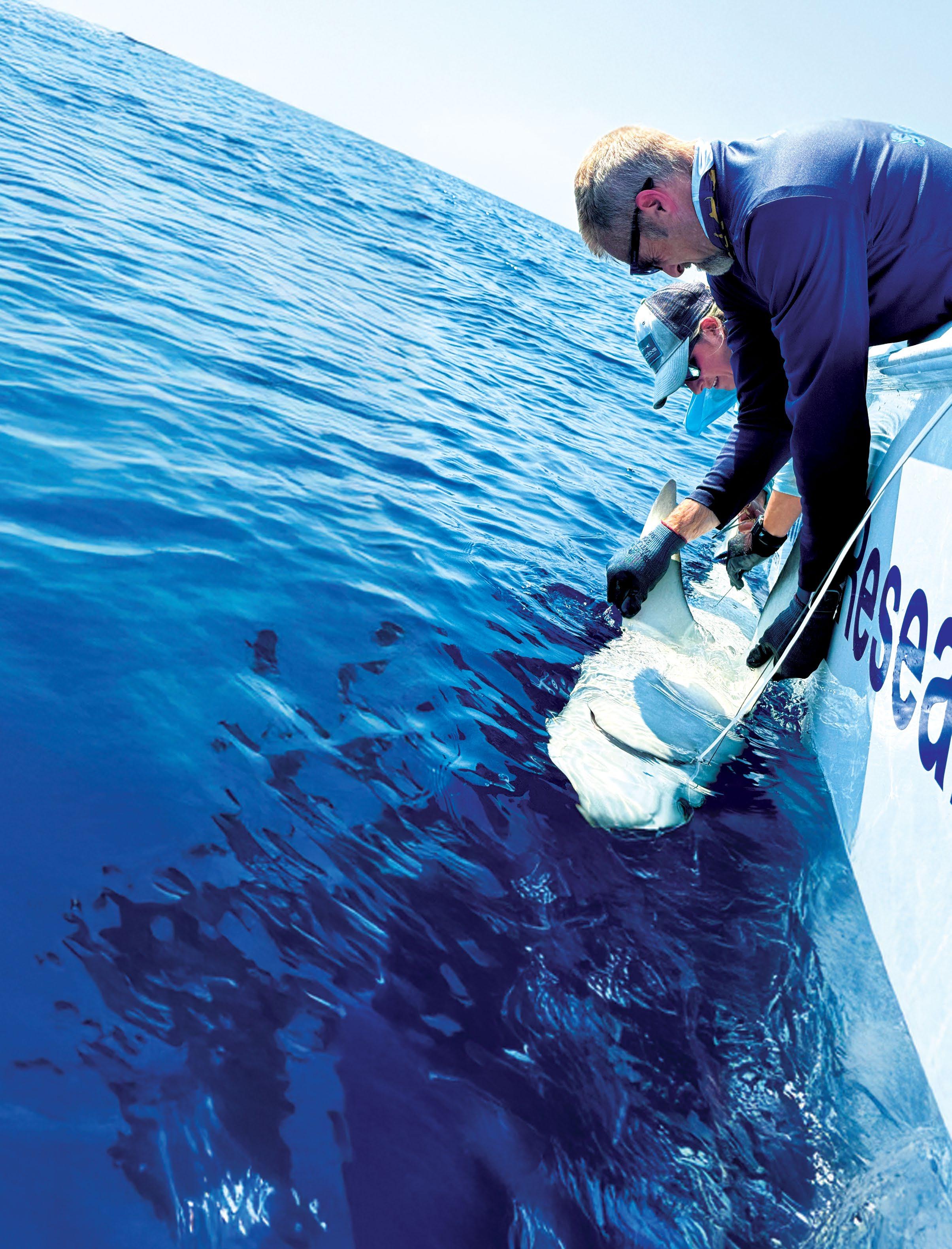
Globally, only 1 catch limit exists for sharks in regional fisheries management organizations.

Hurricanes are more intense. Coastal populations are growing. Flooding from higher storm surges and increased rainfall is heightening the risk for catastrophic damage to the human and built environments in the path of these killer events. Against these complex challenges, FIU scientists are conducting hurricane-related research with all the intensity of a Category 5 storm.
Employed to assess Florida’s hurricane risk to help the State of Florida set windstorm insurance rates in a state where nine property and casualty insurers have gone bankrupt since 2021. The model was developed by a multidisciplinary team of experts in the fields of meteorology, wind and structural engineering, computer science, GIS, statistics and actuarial science. Operated by FIU and funded by the Florida Legislature, the model also carries out stress tests of individual insurance companies and quantifies the economic benefits of mitigation efforts.
Informing storm surge forecasting by the National Hurricane Center and the U.S. Navy’s Joint Typhoon Warning Center and helping local authorities with evaluation decisions.
This line of research focuses on improved impact mapping in hurricane-vulnerable areas throughout the Caribbean and the Bahamas, Central American coastal areas and the South Pacific Island nation of Fiji.
Researching the disproportionate impacts of hurricanes and other weather events on low-income communities in South Florida and helping improve their resilience as part of an Andrew W. Mellon Foundation grant.
Addressing natural hazard risks (including earthquakes, storms, floods, and volcanic eruptions) and developing resilience approaches in Latin America and the Caribbean through collaboration with USAID and local communities and universities.
Developing innovative technologies to construct and retrofit buildings and other civil infrastructure to withstand the impacts of stronger hurricanes and more forceful storm surges.
OUR EXPERTISE $56M
hurricane-related research funding in the past 10 years 242
hurricane-related articles, proceedings, journal articles and books in the past 10 years
FIU’s Extreme Events Institute, led by Director Richard Olson, manages the large-scale Wall of Wind (WoW) – the only university-based hurricane simulator capable of generating
HURRICANE WINDS OF UP TO 157 MPH
Arindam Gan Chowdhury is director and PI of the WoW and Ioannis Zisis is co-director and co-PI. The WoW was created in 2007-08 thanks to a major investment from the State of Florida. Today it is one of only eight National Science Foundation-supported experimental facilities in the U.S. under the Natural Hazards Engineering Research Infrastructure program. The WoW has been used for more than a decade to test construction materials in support of better performancebased design and safer building codes.
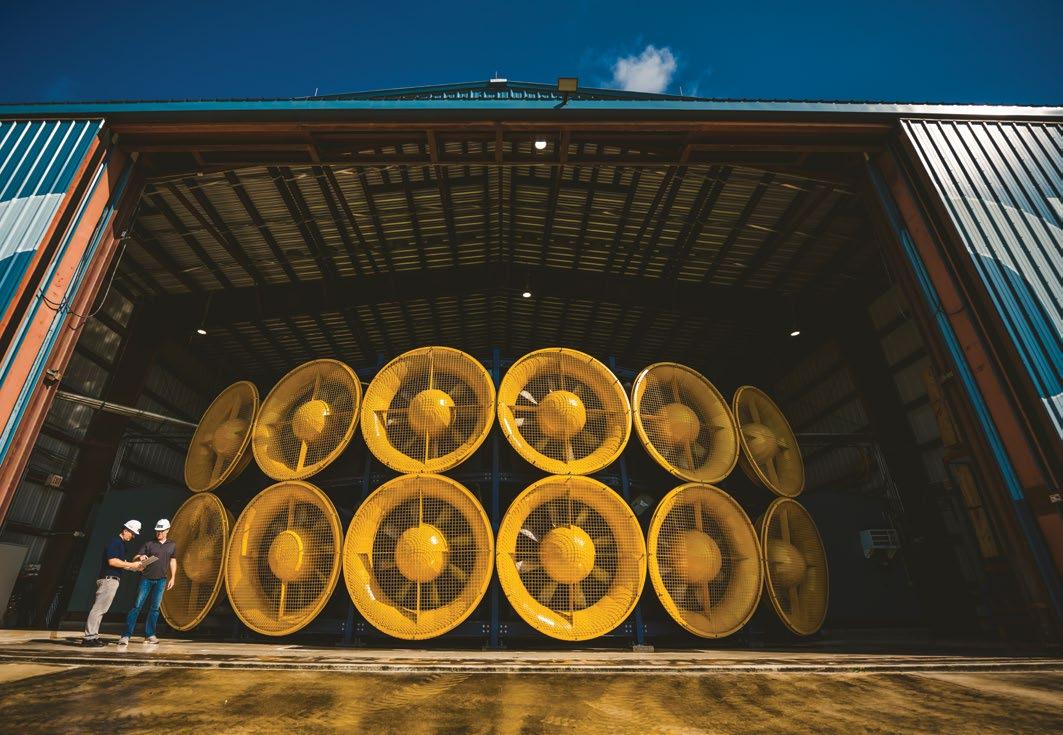
FIU is leading a team of top scientists and engineers from eight universities as part of a $12.8M National Science Foundation grant to design the world’s most powerful combined wind-water-wave testing facility. The National Full-Scale Testing Infrastructure for Community Hardening in Extreme Wind, Surge, and Wave Events, or NICHE, will help scientists understand how stronger hurricanes are impacting coastal environments. With future funding being planned, the new research laboratory will be capable of generating wind speeds of up to 200 miles per hour over an extended water basin to simulate storm surge and wave action on the built and natural environment.

UNIVERSITY PARTNERS
Florida International University (lead)
• Colorado State University
• Georgia Institute of Technology
• Oregon State University
• Stanford University
• University of Florida
• University of Illinois at Urbana-Champaign
• University of Notre Dame
• Wayne State University
Hutcheson and Dargam are now developing an algorithm that uses a digital stethoscope to detect irregular heart sounds for earlier diagnoses.
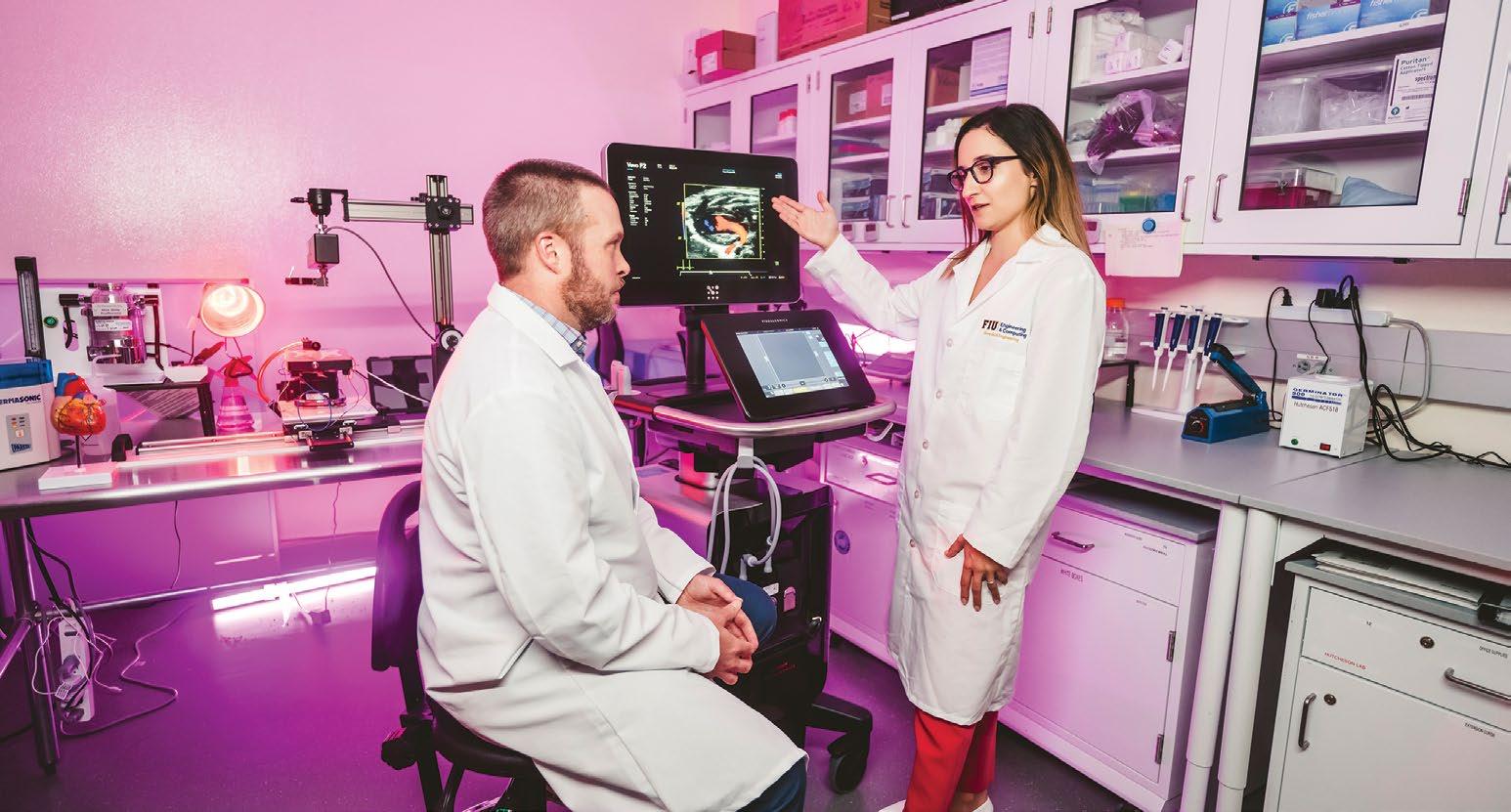
CARDIOVASCULAR DISEASE MOVES IN STEALTH. Once chest pain, fatigue or other physical systems set in, the heart has already been overworked and damaged. Warning signs of an unhealthy heart can lurk – not so quietly – in its many complex sounds. An invention made with support from the National Science Foundation “listens” for changes, providing a way to pinpoint markers of heart failure based on the frequency and durations of sounds in a cardiac cycle. Paired with an algorithm, it would open the door to low-cost diagnostics and better treatment outcomes.
Inventors include biomedical engineering’s Joshua Hutcheson and Valentina Dargam, a recent doctoral graduate from the Hutcheson Cardiovascular Matrix Remodeling Lab. They are working with Dr. Tom Nguyen from Baptist Health Miami Cardiac & Vascular Institute. Hutcheson’s lab is also supported by funding from the Florida Heart Research Foundation and the National Institutes of Health.

THE HERBERT WERTHEIM COLLEGE OF MEDICINE AND BAPTIST HEALTH MIAMI NEUROSCIENCE INSTITUTE are using non-invasive, low intensity-focused ultrasound that could revolutionize care for Alzheimer’s patients.
Magnetic resonance imaging (MRI) precisely guides ultrasound waves to disrupt the blood-brain barrier and disturb clumps of beta-amyloid protein plaques that block communication between brain cells, leading to cognitive decline. High-intensity ultrasound technology has offered promise for Parkinson’s patients. The hope is similar results will be seen with low-intensity ultrasound in Alzheimer’s patients. Dr. Patricia Junquera, the medical school’s chair of psychiatry and behavioral health, and Dr. Michael McDermott, the medical school’s chief of the neuroscience division and chief medical executive of Baptist Health Miami Neuroscience Institute, are co-PIs of this FDAapproved clinical trial, part of the Florida Brain State Program in collaboration with Insightec.

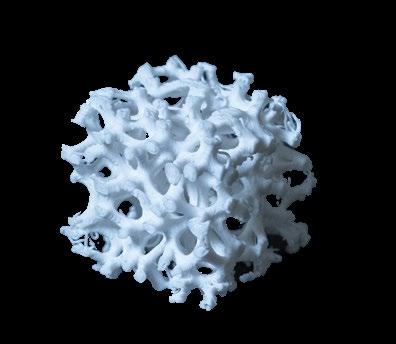
DOCTORS SHARED CHALLENGES of helping young patients with osteosarcoma, a type of bone cancer, with Anamika Prasad, associate professor in the College of Engineering & Computing. In the majority of cases, treatment requires a complicated surgery to remove sections of tumorriddled bone. Implants made of metal or other sturdy manmade materials are not a good option for kids with still-growing bones.
Leveraging her materials science and civil engineering background, Prasad is developing a unique ‘scaffold’ implant design. Similar to temporary scaffolding used by construction workers, 3D-printed structures made of FDA-approved material will provide places for bone cells to cling and climb on so they can build bone over time.
Prasad works closely on this research with Dr. Juan Prettel, chief of musculoskeletal oncology surgery at Baptist Health Miami Cancer Institute. With support from the Casey DeSantis Florida Cancer Innovation Fund through the Florida Department of Health, they are now developing a cost-effective, streamlined framework.

AMYLOID PLAQUES are a major focus of Alzheimer’s research and drug development efforts. But there’s another less understood hallmark of the disease: chronic neuroinflammation. Could blocking these inflammatory waves ward off cognitive impairment? Through a promising new Alzheimer’s treatment discovery, Kyung Bo Kim, professor of cellular and molecular medicine in the Herbert Wertheim College of Medicine and Center for Translational Science, has found an answer: Yes.
With funding from the National Institute on Aging, Kim identified immunoproteasome inhibitor compounds that controlled inflammation. Next up: the investigational new drug enabling study, a crucial step before applying for clinical trials. Kim has found these same compounds have proven highly effective at stopping age-related macular degeneration.

ARKINSON’S DISEASE affects about 1 million Americans. Kim Tieu and his research group have now identified a key protein that could lead to new therapies for Parkinson’s and other brain conditions. Their studies found partially blocking dynamin-related protein-1 (Drp1) helped coax cells in the brain to clean up toxic proteins that accumulate and are involved in Parkinson’s disease.
Tieu’s lab has identified several FDA-approved compounds that target Drp1 with a $6.6 million National Institute of Environmental Health Sciences’ Revolutionizing Innovative, Visionary Environmental Health Research (RIVER) grant. Currently, they are testing these compounds as potential treatments for Parkinson’s.
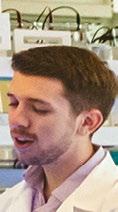


DAY 1 5:34 PM Received sample
DAY 1 7:25 PM Preparing sample
DAY 2 10:48 AM Testing drugs




SCIENTISTS NOW UNDERSTAND more about cancer today than ever before in history. But with every new discovery, new mysteries emerge about its true nature. For starters, cancer is not one single disease. There’s hundreds of types and subtypes. And because every person is different, so too, is every person’s cancer – meaning one sizefits-all treatment strategies don’t always work.
That’s why FIU cancer researcher Diana Azzam developed a unique functional precision medicine approach to guide personalized cancer therapies in real-time. It combines genetic testing with the power of highly sophisticated drug screening where hundreds of FDA-approved cancer and non-
cancer drugs are tested on living cells derived from the patient’s tumor. In Azzam’s words, the goal is to find the “right drug for the right person at the right time.” From start to finish, the process takes a little under a week.
With funding from the Florida Department of Health Live Like Bella Pediatric Cancer Research Initiative, Azzam’s lab collaborated with Nicklaus Children’s Hospital to conduct a first-of-its-kind clinical trial to guide treatments for some of the deadliest children’s cancers. According to the study’s results, published in Nature Medicine, Azzam’s method provided safer, more readily accessible, effective and affordable options to doctors. Most important, those recommendations impacted
Azzam with patient 13

the children – 83% showed improved outcomes in response and survival over the course of the study.
“The take-home message is we can use this approach to direct the next line of cancer therapy for children and adults,” says Azzam, who leads the Center for Advancing Personalized Cancer Treatments at the FIU Robert Stempel College of Public Health & Social Work. “This is feasible. It works.”
Azzam is currently leading larger personalized cancer treatment clinical trials for both children and adults. Her lab is also set to become the first federally certified large-scale lab dedicated to functional cancer drug testing in Florida with a $2 million appropriation from the State of Florida spearheaded by State Senator Bryan Avila and former State Senator Anitere Flores. This will mean testing will also be open to people outside of Azzam’s current clinical trials. It can’t happen soon enough. Pleas for help from cancer patients and their families fill Azzam’s inbox daily, seeking enrollment in her trials. “We owe this to them,” Azzam said. “They’re counting on us to keep pushing this forward.”
For more information about Azzam’s research and current clinical trials, please visit http://go.fiu.edu/pct.
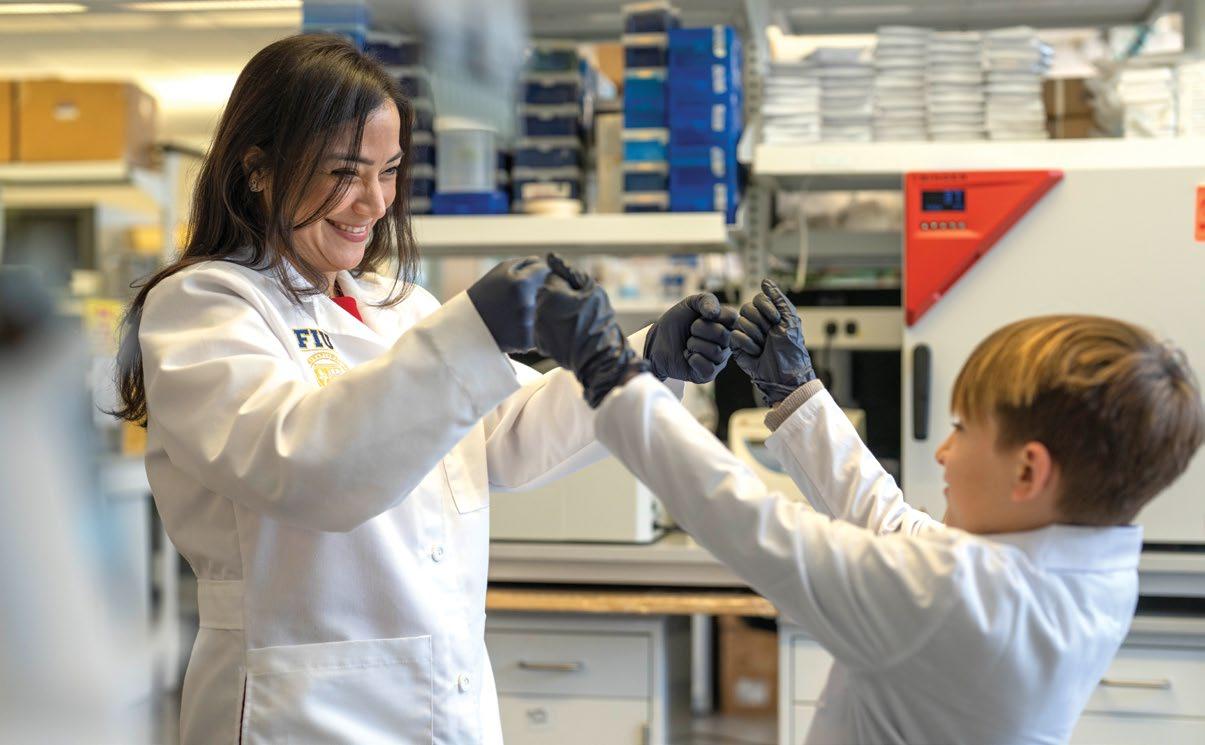
PATIENT SPOTLIGHT
Logan Jenner was three years old when doctors diagnosed him with acute myeloid leukemia. After years of treatment, his cancer returned.
In the wake of the relapse, Logan’s oncologist Dr. Maggie Fader – who led the clinical trial with Azzam – along with his entire team of doctors started searching for a more tailored treatment. They quickly enrolled Logan in the clinical trial. A sample of his tumor was tested to determine which medications were most effective against his cancer. Those tests guided his treatment, and in 33 days, he reached remission and remains cancer-free today, more than two years later.
Learn more about Patient 13

In a move addressing Florida’s projected physician shortfall of nearly 18,000 by 2035, the Herbert Wertheim College of Medicine and Baptist Health joined forces in 2023 to establish an Academic Medical Center Enterprise. The alliance is expanding physician training, research and patient care in South Florida.
Baptist Health is the largest not-for-profit health care organization in the region with 12 hospitals, more than 28,000 employees and more than 200 outpatient and urgent care facilities across four counties. For years it has led clinical rotations for FIU medical students in 40 specialties and subspecialties. Now it will become a statutory teaching hospital with the goal of attracting highly specialized physicians to lead groundbreaking research and clinical innovation.
FIU students in many health programs will benefit from the increased research as well as from a collaboration with the Miami Cancer Institute at Baptist Health. The alliance will also streamline residency training and reduce redundancies. Programs beginning in 2025 include internal medicine and neurology – specialty areas where Florida is experiencing a current supply/demand deficit –as well as diagnostic radiology.
“It will be a transformative partnership for the college of medicine, for FIU, for Baptist and really, for the community,” says Dr. Juan Cendan, dean and senior vice president for health affairs of the Herbert Wertheim College of Medicine.
Teaching hospitals carry a host of positives for the region in which they are located, among them greater retention of the physician residents they train. And when physicians attend medical school and complete a residency in the same city, the numbers jump even higher. Nearly 80% of those who complete medical school and residency in the same city settle there, according to the Association of American Medical Colleges.
“This collaboration is a testament to our shared commitment to pioneering healthcare solutions and creating a culture of continuous learning and innovation,” says Dr. Jack Ziffer, Baptist Health executive vice president and chief clinical officer.
A planned 100,000-square-foot medical center reflects the promise and purpose of a transformative alliance between the Herbert Wertheim College of Medicine and Baptist Health. The collaboration is already reshaping health care in South Florida, the Sunshine State’s most populous region.
Just as the Florida Legislature nearly two decades ago supported establishing the Herbert Wertheim College of Medicine, it applauded the alliance with Baptist by appropriating $100 million in initial funding for the campus building. Completion is expected in 2028.
FIU President Kenneth A. Jessell emphasized that the partnership will raise health care standards. “There is a great deal of excitement around this collaboration because it elevates the work both FIU and Baptist are doing. We are creating a rich ecosystem that will result in some of the best health care in the nation.”
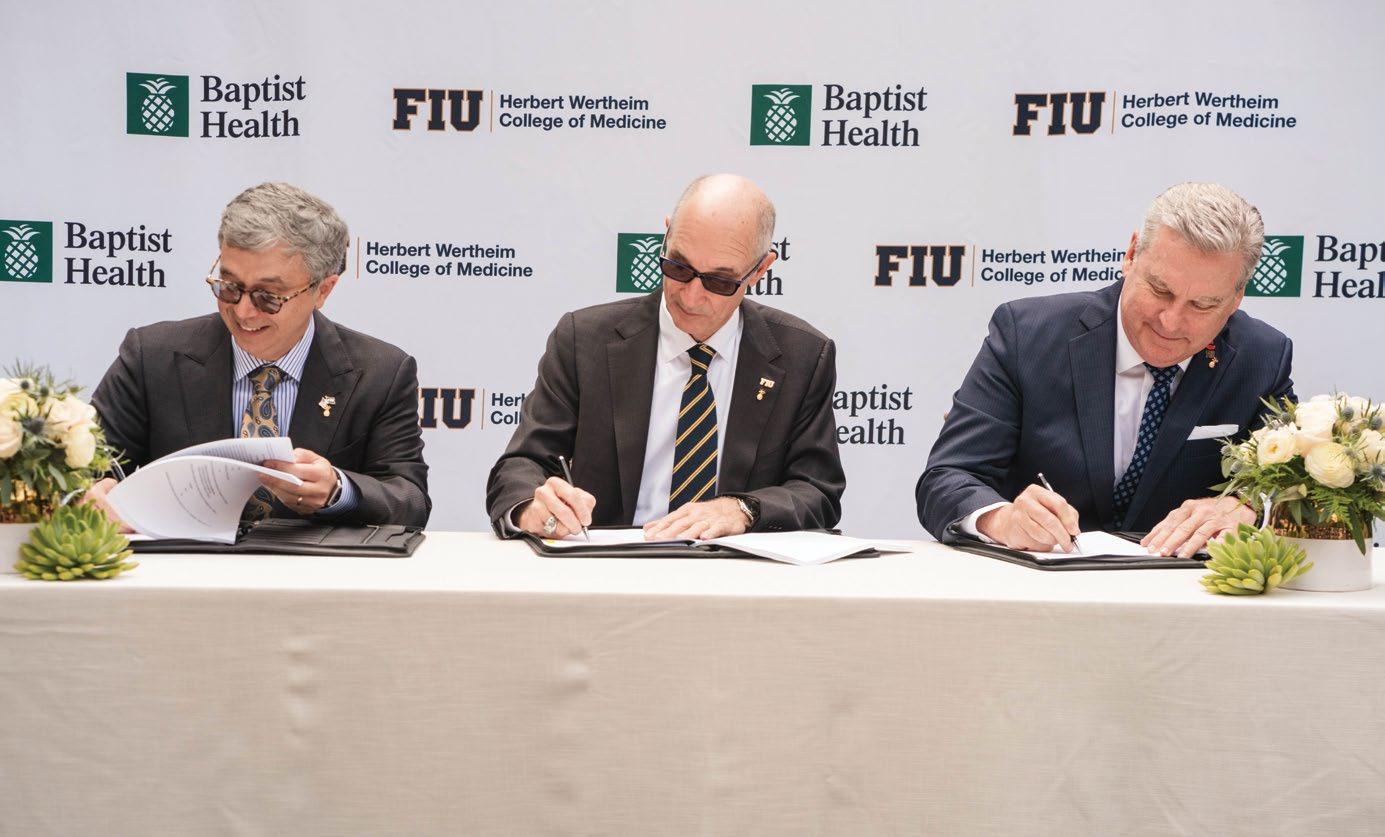
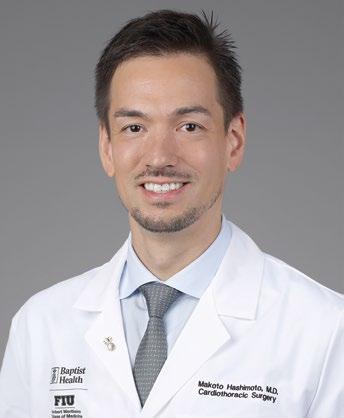
FIU and Baptist Health have achieved a significant milestone in their strategic alliance. FIU has appointed Dr. Makoto Hashimoto, an internationally renowned cardiac surgeon, a professor and director of robotic cardiac surgery at FIU Herbert Wertheim College of Medicine. He will see patients at Baptist Health Miami Cardiac & Vascular Institute, located at Baptist Health Baptist Hospital. He will perform surgeries at both Baptist Hospital and Baptist Health South Miami Hospital.
Hashimoto specializes in robotic and minimally invasive cardiac surgery procedures, which provide a safer, more advanced alternative to open-heart surgery, allowing patients to recover faster and resume their normal activities sooner.
Before joining FIU and Baptist Health, Hashimoto served as director of the Center of Minimally Invasive Cardiac Surgery and Robotic Cardiac Surgery at Sapporo University, one of Japan’s largest volume heart programs.
Hashimoto earned his medical degree at Shimane University School of Medicine and Ph.D. in Medical Science at Sapporo Medical University, both in Japan. He completed two cardiac surgery residencies and two cardiovascular fellowships. He is fluent in English, Japanese and Finnish, and has published numerous scientific articles in peerreviewed journals.
FIU soared into the TOP 50 best public universities and TOP 100 best national universities, which include both private and public institutions, according to the latest rankings published by U.S. News & World Report.
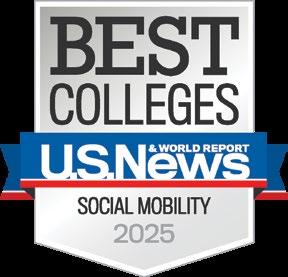
National Universities
U.S. News & World Report, 2025
Research Expenditures in the Last Five Years TOP 10
Research Expenditure Growth 2012-2022 Carnegie RI Public Universities
(Chronicle of Higher Education analysis of NSF data)
Ready to collaborate? Visit go.fiu.edu/ResearchCollaboration to learn more.
TOP 20
Economic ROI in a College Degree Degree Choices, 2025
TOP 20
U.S. Utility Patents
U.S. Public Universities
(National Academy of Inventors and Intellectual Property Owners Association)